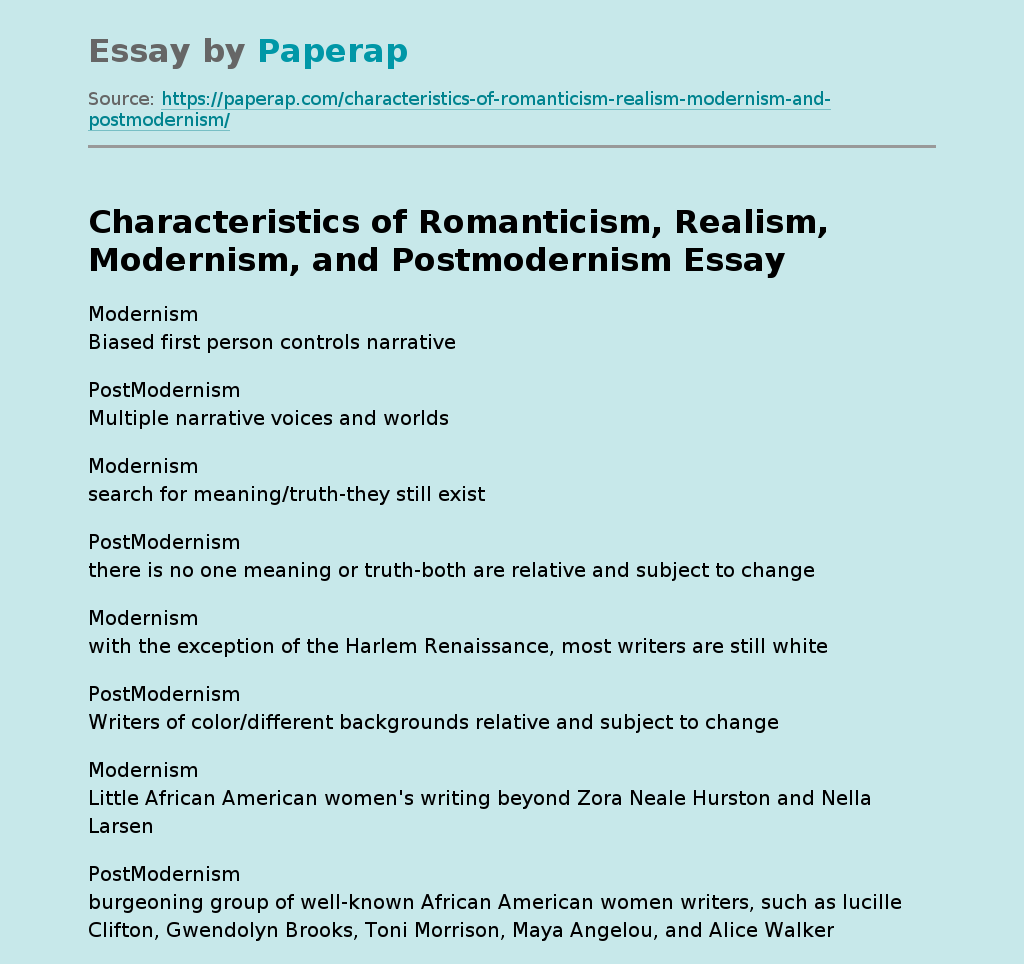Characteristics of Romanticism, Realism, Modernism, and Postmodernism
Essay,
Pages 3 (633 words)
Views
145
Modernism
Biased first person controls narrative
PostModernism
Multiple narrative voices and worlds
Modernism
search for meaning/truth-they still exist
PostModernism
there is no one meaning or truth-both are relative and subject to change
Modernism
with the exception of the Harlem Renaissance, most writers are still white
PostModernism
Writers of color/different backgrounds relative and subject to change
Modernism
Little African American women’s writing beyond Zora Neale Hurston and Nella Larsen
PostModernism
burgeoning group of well-known African American women writers, such as lucille Clifton, Gwendolyn Brooks, Toni Morrison, Maya Angelou, and Alice Walker
Modernism
No Deconstruction/Emphasis on loss
PostModernism
Deconstruction (a theoretical stance coined by French philosopher Jacques Derrida in 1967 and espoused in of Gramatology that same year)
Modernism
Sci-fi stuff had been written in 19th century (Mary Shelley’s Frankenstein and Poe’s stuff), but it hadn’t gained major popularity as genre
PostModernism
Sci-fi begins to be used as a term in 1954 at UCLA
Modernism
Alarm regarding global changes and a senses of deep and profound disillussionment
PostModernism
_____ Writers have accepted the world as chaotic and therefore are more willing to play wackily with it and even create humorous, satirical, allegorical settings that go against the grain
Modernism
Less overt, pedantic didactism (Gatsby might be an exception?)(Basically means less clear lesson or moral in stories)
PostModernism
Anti-war, protest literature abounds The Beat Generation, the Counter-Culture movements
Modernism
Lost Generation
PostModernism
Beat Generation
Modernism
Harlem Renaissance
PostModernism
Angry, Black Arts Movement (1965-1975) Response to Malcom X’s Assasination
Modernism
No Native American renaissance
PostModernism
Native American Renaissance(1970-1985, although still really going on)
Modernism
Self-Reflexive (poems about poems)
PostModernism
Even more self-reflextivity, even on an intense and personal level
Modernism
Imagist Poetry about things as things
PostModernism
The confessional school of poetry-intensely personal poetry about abortion, alcoholism, rape, suicide, etc.
Modernism
Non-traditional structure
PostModernism
Even more non-traditional structure-past blends with present
Modernism
Journalist becomes writers of fiction, and they aim to tell the truth; non-fiction is to be trusted
PostModernism
Conflation of non-fiction and fiction; reality television develops, and the media is highly biased and politicized-new journalism develops
Modernism
Rejection of science/technology; art was a repository for experiencing the world other than that offered by science
PostModernism
Growing acceptance of science and technology, or at least a realization that it can no longer be ignored
Modernism
Homogeneity
PostModernism
Heterogeneity
Romanticism
Values feeling over reason
Romanticism
Place faith in inner experience and the power of the imagination
Romanticism
Shuns the artificiality of civilization and seeks unspoiled nature
Romanticism
Prefers youthful innocence to educated sophistication
Romanticism
Champions individual freedom and worth
Romanticism
looks backward to the wisdom of the past and distrusts progress
Romanticism
Finds beauty and truth in the exotic, the supernatural realm, ands the inner world of the imagination
Romanticism
Sees poetry as the highest expression of the imagination
Romanticism
Finds inspiration in myth, legend, and folklore
Realist
Rejection of the idealized, larger-than-life hero of Romantic literature
Realist
Detailed depiction of ordinary characters in realistic events
Realist
Emphasis on characters from cities and lower classes
Realist
Avoidance of the exotic, sensational, and overly dramatic
Realist
Use of everyday speech patterns to reveal class distinctions
Realist
Focus on the ethical struggles and social issues of real-life situations
Modernism
Emphasis on bold experimentation and style and form
Modernism
Rejection of traditional themes, subjects, and forms
Modernism
Sense of disillusionment and loss of faith in the American Dream
Modernism
Rejection of sentimentality and artificiality
Modernism
Rejection of the ideal of a hero as infallible in favor of a modern hero who is flawed and disillusioned but demonstrates “grace under pressure”
Modernism
Interest in inner workings of mind, expressed through narrative techniques such as stream of consciousness
Modernism
Revolt against spiritual debasement of modern world
Romanticism
Innocence
Romanticism
Inspiration from nature
Romanticism
Imagination
Romanticism
Inner experience
Romanticism
Intuition
Characteristics of Romanticism, Realism, Modernism, and Postmodernism. (2019, Feb 07). Retrieved from https://paperap.com/characteristics-of-romanticism-realism-modernism-and-postmodernism/
